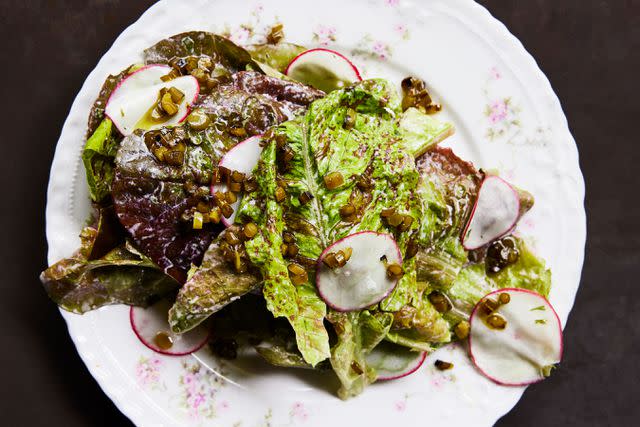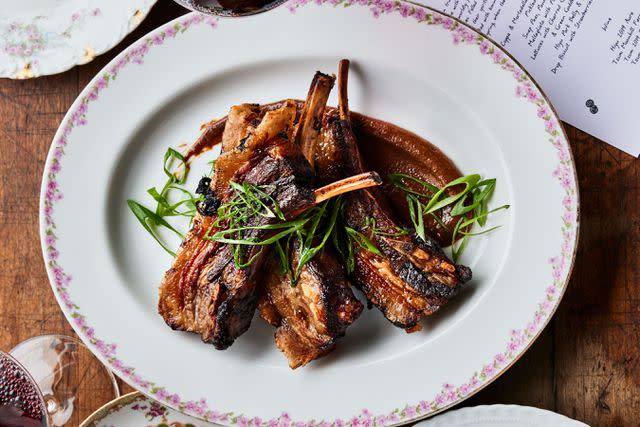This Oregon Wine Farm Makes Natural Wine the Old World Way
At Hiyu Wine Farm, a commitment to permaculture yields wild and complex field blends and a well-set winemaker’s table

Eva Kolenko
The farmhouse and hilly vineyards at Hiyu Wine Farm in Hood River, Oregon.The first time I met winemaker Nate Ready, he was pouring his wines at Pairings wine bar in Portland, Oregon. With his long salt-and-pepper beard and intense yet humble manner, Ready reminded me of a cross between Rasputin and a young Dumbledore — if Dumbledore were a wizard of wine. I’d tasted natural wines before (that is, wines made from organic grapes using native yeast and minimal intervention), but these, from Hiyu Wine Farm in the Columbia River Gorge, were remarkable. One was a field blend of red varietals, another was a pét-nat, and yet another was an orange wine that had had skin contact for 100 days. They had one thing in common: They all tasted alive.
“You taste his wines, and they are unlike anything on the West Coast,” says Brian McClintic, founder and owner of Viticole, a wine club that creates custom blends with organic producers here and abroad. “You can’t really compare them to anything; they’re so distinctive.”
Whereas some winemakers see a division between winemaking and farming, for Ready, the two are inseparable. When you visit Hiyu, high above the Hood River, you get the impression right away that Ready and his co-founder, China Tresemer, work using the principles of biodynamic farming. Plump pigs joyfully stampede down the slope of the vineyard, and ducks, speckled guinea fowl, and Dexter cows keep the grasses down and fertilize the vines. Their guiding philosophy, however, is permaculture, an even more holistic way of farming that uses a diversity of plants and animals to create resiliency. The farm, a former pear orchard with a view of Mount Hood, evokes an English smallholding farm. McClintic, with a nod to J.R.R. Tolkien, calls it “Shire-y.”

Eva Kolenko
Hiyu Wine Farm’s herd of Dexter cows.Tresemer and Ready grow 112 varietals of grapes on the property. (Most vineyards grow only a handful.) And most of Hiyu’s vineyard is planted with field blends. An Old World practice of planting varieties together in the same plot and then co-fermenting the grapes together to make a wine, field blends are rare in U.S. viticulture today. But this wasn’t always the case. Pre-Prohibition, Ready says, most vineyards were planted this way. After drinking wine from old California vineyards that were planted with field blends and also seeing Marcel Deiss in Alsace successfully convert his sites from monovarietals to field blends, Ready was convinced it made sense here. He and his winemaking team also forage other fruits from the property and co-ferment them with grapes to make beverages that blur the distinction between cider and wine. One, called Espina, used a wine base that Tresemer made in 2017 with Pinot Gris grapes from vines that had been trained so they climbed up the trunks of fruit trees. She co-fermented the grapes with the fruits that grew in the hedgerows beneath: pears, elderberries, blackberries, plums, and rose hips. The second component of Espina was a wine made in 2018 — pears fermented on the skins of Gewürztraminer and barrel-aged for two years. Finally, whole blackberries and plums were added to a vat of fermenting pears, and the fruit was macerated on the skins for two weeks before pressing. In 2020, Hiyu’s two farm fellows, Kathline Chery and Yakira Batres, blended these three components together to make the resulting wine. The Hiyu team made a second version of Espina last spring.
To experience Hiyu to its fullest, you need to visit the farm, as I did, for a tour of the 30-acre property and a wine-tavern lunch. Ready or Tresemer will lead you through the farm — from the “forest garden” to the pear orchard, which provides fruit for an eau-de-vie and various other concoctions like Espina. You’ll wander the vineyards, which are populated by the aforementioned speckled guinea fowl, Dexter cows, and pigs — the latter a cross, I learned, between Kunekune and American Guinea Hogs.
Ready’s field blends, like Corvus and Falcon Box, are wild and complex. But even his more affordable Smockshop Band wines are creatively ambitious and delicious. The Smockshop Band Columbia Valley Red is a blend of more than 50 varieties from four different vineyards, and it was fermented in a myriad of ways, with most of the grapes in barrels for three to five years. It’s a multidimensional wine that has the fruit-forwardness of a Pinot yet a deeper, spicier, more tannic side as well. And it’s a mere $44 a bottle; not inexpensive, but given the labor involved in making it, a bargain.

Eva Kolenko
A springtime glass at Hiyu Wine Farm.Such wines must be enjoyed with food. The meal my friend and I had — snap peas with pancetta over maltagliati pasta with porcini; luscious pork belly and black garlic; and lettuces with charred garlic scapes and a green goddess dressing — was unfussy and delicious. In-house chef Jason Barwikowski has been with Hiyu since the very beginning, and he’s as inventive in the kitchen as Ready is in the vineyard and cellar. Almost all of the ingredients for his dishes come from the farm. Periodically, Ready came outside to pour us another taste of wine in our elegant handblown Zalto glasses. Before dessert, he arrived with a plate of Adarre cheese with a lush persimmon from the very tree Tresemer had pointed out earlier. As we tucked into our last course, a financier with apple butter, a crew of big jolly pigs ran down the vineyard’s slope. We raised our glasses to the pigs, who, like us, were living life to its fullest here at Hiyu.
Maltagliati with Mushrooms and Pea Tendrils

Greg Dupree / Prop Styling by Christine Keely / Food Styling by Chelsea Zimmer
Irregularly shaped maltagliati pasta is coated in a silky pan sauce that comes together quickly with reserved pasta cooking liquid and Parmesan cheese. Cremini or trumpet mushrooms make an excellent substitute if fresh porcinis aren’t available.
Pickled Garlic Scape and Radish Salad with Green Goddess Dressing

Eva Kolenko
Refreshing, tangy, and light, this simple salad highlights pickled aromatics and tender greens coated in a creamy, herb-forward dressing. Macerating raw shallots in red wine vinegar highlights their natural sweetness and mellows any sharpness, making them a natural complement to the garlic scapes and tender butter lettuce.
Pork Ribs with Black Garlic Miso Glaze

Eva Kolenko
The complex glaze, robustly umami-rich from braised shallots, miso, and dried shiitake mushrooms, adds a sweet, savory depth to tender pork ribs. Brushing the meat with a pastry brush is the easiest way to apply the glaze to the hot seared ribs. Let the rib slab cool completely before slicing to allow the flavorful juices to reabsorb into the meat.
Biscuits with Strawberries and Whipped Cream

Eva Kolenko
This riff on a nostalgic dessert comes together quickly and makes the most of strawberries that macerate with lemon and balsamic vinegar. Using frozen grated butter when mixing the dough ensures a tender and flaky biscuit to soak up all the tangy-sweet berry juice.
For more Food & Wine news, make sure to sign up for our newsletter!
Read the original article on Food & Wine.

